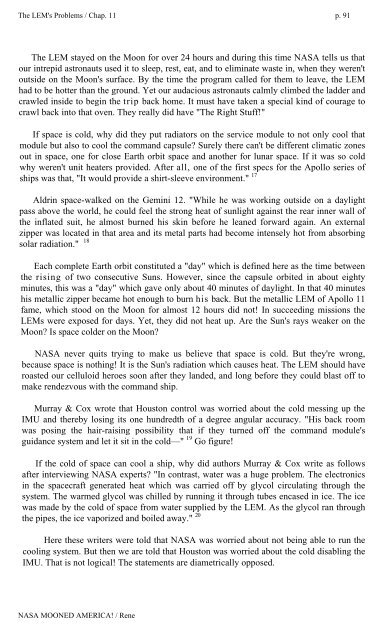Rene-NASA-Mooned-America
Rene-NASA-Mooned-America
Rene-NASA-Mooned-America
You also want an ePaper? Increase the reach of your titles
YUMPU automatically turns print PDFs into web optimized ePapers that Google loves.
The LEM's Problems / Chap. 11 p. 91<br />
The LEM stayed on the Moon for over 24 hours and during this time <strong>NASA</strong> tells us that<br />
our intrepid astronauts used it to sleep, rest, eat, and to eliminate waste in, when they weren't<br />
outside on the Moon's surface. By the time the program called for them to leave, the LEM<br />
had to be hotter than the ground. Yet our audacious astronauts calmly climbed the ladder and<br />
crawled inside to begin the trip back home. It must have taken a special kind of courage to<br />
crawl back into that oven. They really did have "The Right Stuff!"<br />
If space is cold, why did they put radiators on the service module to not only cool that<br />
module but also to cool the command capsule Surely there can't be different climatic zones<br />
out in space, one for close Earth orbit space and another for lunar space. If it was so cold<br />
why weren't unit heaters provided. After all, one of the first specs for the Apollo series of<br />
ships was that, "It would provide a shirt-sleeve environment." 17<br />
Aldrin space-walked on the Gemini 12. "While he was working outside on a daylight<br />
pass above the world, he could feel the strong heat of sunlight against the rear inner wall of<br />
the inflated suit, he almost burned his skin before he leaned forward again. An external<br />
zipper was located in that area and its metal parts had become intensely hot from absorbing<br />
solar radiation." 18<br />
Each complete Earth orbit constituted a "day" which is defined here as the time between<br />
the rising of two consecutive Suns. However, since the capsule orbited in about eighty<br />
minutes, this was a "day" which gave only about 40 minutes of daylight. In that 40 minutes<br />
his metallic zipper became hot enough to burn his back. But the metallic LEM of Apollo 11<br />
fame, which stood on the Moon for almost 12 hours did not! In succeeding missions the<br />
LEMs were exposed for days. Yet, they did not heat up. Are the Sun's rays weaker on the<br />
Moon Is space colder on the Moon<br />
<strong>NASA</strong> never quits trying to make us believe that space is cold. But they're wrong,<br />
because space is nothing! It is the Sun's radiation which causes heat. The LEM should have<br />
roasted our celluloid heroes soon after they landed, and long before they could blast off to<br />
make rendezvous with the command ship.<br />
Murray & Cox wrote that Houston control was worried about the cold messing up the<br />
IMU and thereby losing its one hundredth of a degree angular accuracy. "His back room<br />
was posing the hair-raising possibility that if they turned off the command module's<br />
guidance system and let it sit in the cold—" 19 Go figure!<br />
If the cold of space can cool a ship, why did authors Murray & Cox write as follows<br />
after interviewing <strong>NASA</strong> experts "In contrast, water was a huge problem. The electronics<br />
in the spacecraft generated heat which was carried off by glycol circulating through the<br />
system. The warmed glycol was chilled by running it through tubes encased in ice. The ice<br />
was made by the cold of space from water supplied by the LEM. As the glycol ran through<br />
the pipes, the ice vaporized and boiled away." 20<br />
Here these writers were told that <strong>NASA</strong> was worried about not being able to run the<br />
cooling system. But then we are told that Houston was worried about the cold disabling the<br />
IMU. That is not logical! The statements are diametrically opposed.<br />
<strong>NASA</strong> MOONED AMERICA! / <strong>Rene</strong>


